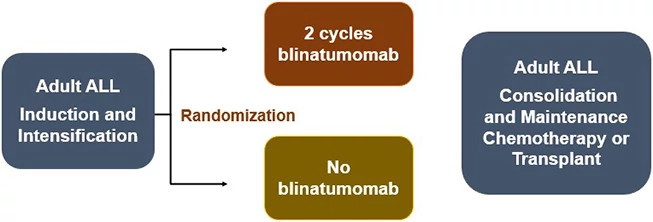Acute lymphoblastic leukemia (ALL) is a rare hematologic malignancy with fewer than 10,000 patients diagnosed each year in the United States; approximately one-half of them are children. While the treatment of childhood ALL is successful in most cases, only about 40% of adults are cured (Rowe et al, Blood 2005). Incremental improvements have been achieved in the last decade with increased use of pediatric-type chemotherapy regimens for younger adults ( <50 years), the addition of tyrosine kinase inhibitors (such as imatinib and dasatinib) to the treatment of Philadelphia-chromosome positive (Ph+) B-cell ALL, and increased use of allogeneic hematopoietic stem cell transplantation. However, for most adults, available standard treatment options are inadequate. Fortunately, the therapeutic landscape for ALL is rapidly evolving.
New Therapies for ALL
In the last couple of years, several new agents have been approved for the treatment of B-cell ALL. In 2014, the FDA approved blinatumomab, a bispecific T-cell engager (BiTE) monoclonal antibody that simultaneously binds and brings together leukemia cells expressing the B-cell antigen CD19 and cytotoxic T-cells capable of eradicating those leukemias. Blinatumomab has been shown to eliminate "minimal residual disease" (Topp et al. J Clin Oncol 2011) as well as improve remission rates and survival in patients with frankly relapsed/refractory disease compared to chemotherapy (TOWER trial, CR/CRi: 44% versus 25%, P <0.001; median OS 7.7 versus 4.0 months, P=0.01; Kantarjian et al. N Eng J Med 2017).
In July 2017, a second monoclonal antibody — inotuzumab ozogamicin — was approved. Inotuzumab targets CD22, another B-cell antigen expressed in B-cell ALL, and is covalently linked to a cytotoxic agent, calicheamicin. The approval of inotuzumab was based on the phase III INO-VATE trial led by Dr. Daniel J. DeAngelo and colleagues (Kantarjian et al. N Eng J Med 2016). In INO-VATE, patients with relapsed B-cell ALL treated with inotuzumab had a superior rate of complete remission compared to patients treated with conventional chemotherapy (80.7 versus 29.4%, P <0.001); there was also an improvement in survival.
Finally, in a self-described "historic action," the Food and Drug Administration in August 2017 approved chimeric antigen receptor T-cell therapy for young adults with B-cell ALL. Tisagenlecleucel (a CAR-T previously known as CTL019) is associated with remission rates of 80% (Maude et al. N Eng J Med 2014); these remissions have proven to be durable in a large portion of cases.
On the Horizon for ALL
At Dana-Farber Cancer Institute, efforts continue to further treatment options for patients with ALL. For initial treatment, available studies led by Dr. DeAngelo include Dana-Farber protocol 17-717 studying the addition of inotuzumab consolidation to standard chemotherapy for young adults (18-40 years) with newly diagnosed CD22+ B-cell ALL (see Figure 1 below); Dana-Farber protocol 15-709 studying the addition of blinatumomab consolidation to standard chemotherapy for adults (40-70 years) with newly diagnosed CD19+ B-cell ALL (see Figure 2 below); and Dana-Farber protocol 16-648 (studying the addition of venetoclax to low-dose chemotherapy in older adults with ALL. For relapsed/refractory disease, Dr. DeAngelo is currently site PI of a study, Dana-Farber protocol 14-117, investigating ABL001, a novel tyrosine kinase inhibitor, for the treatment of refractory Ph+ B-cell ALL. Also soon to open is Dana-Farber protocol 17-731, led at Dana-Farber by Dr. Marlise Luskin, which will study the combination of blinatumomab with the checkpoint inhibitors PD-1 (nivolumab) and CTLA-4 (ipilimumab) in patients with relapsed CD19+ B-ALL. Pre-clinical in vitro studies show that blockade of the PD-1 and CTLA-4 pathways in combination with blinatumomab enhances the ability of T-cells to kill ALL cells. In sum, the outlook is increasingly hopeful for patients diagnosed with ALL, particularly those with B-cell disease.



